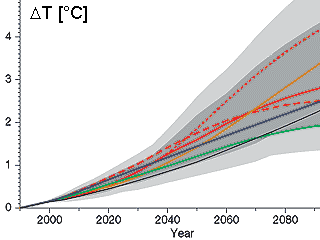|
|
 |
|
|
|
 |
 |
|
|
 |
Aerosol-impacts as the climate models' feet of clay
Can it even become hotter than we feared up to now? |
|
The forecasts about the climate of tomorrow are not really optimistic. On June 30th 2005 the science magazine 'Nature' published an article which even amplifies the fear about a hot future on our planet. The authors say that today's dust in the air and its potential decrease in the future is not sufficiently included in the present climate models. The more that particles cool the Earth at the moment, the hotter the future climate may become. |
 |
 |
|
1. Climate scenarios of the Intergovernmental Panel on Climate Change IPCC: The potential increase in the global temperature is calculated for diverse estimations. This does not only include the climate factors themselves. Developments in the world’s population, the global economy, energy policy and new technologies also have to be considered.
Please click the image in order to see the original graph.
Source: IPCC TAR - Summary for Policymakers
|
|
 |
 The larger the present-day aerosol cooling, the more extreme the temperature increase in the future. The larger the present-day aerosol cooling, the more extreme the temperature increase in the future.
The present climate scenarios were initially developed from 1990 – 1992 and have been since been improved (IPCC scenarios). The models are partially based on estimations of climate changes in the distant past (paleoclimatology) as temperature changes and developments in the carbon dioxide content of the air between glacial times and interglacials, i.e. warm periods in the Earth's history. However, many factors in the climate models are verified by simulating the changes in the last 200 years because from this period we have much more reliable data from modern meteorological measurements and scientific observation.
|
Over recent years scientists have learned a lot about the influence of aerosols on climate. Human made aerosols have been influencing our climate in the last 200 years since industrialisation began. Most likely they have acted like a break preventing a too strong temperature increase while the continuous increase in greenhouse gases fostered the process of global warming. In order to protect our health we would like to stop applying this unwanted brake and begin to filter more and more the particles coming from diverse processes in industry and transport. This means, however, the conditions of the future climate cannot be compared anymore with the test conditions for our climate models.
|
 |
|
|
The calculations of the authors in nature say: The aerosol cooling is like a protective coating of our climate system. It did not react very much on the pinpricks exacerbated by the continuous increase in greenhouse gas emissions. We do not know how thick this protective layer really is but the thicker it is today, the more we have to worry that the future climate will react very sensitively to the increasing greenhouse gases, when this protective layer is more and more reduced.
|
 |
 |
|
3. What is included in a climate model and how is it approved? All parameters which are put in are subject to some uncertainty. Data from the climate of the former millennia are rare. Therefore the comparison with more recent measurement values is an important method in order to validate the models.
Scheme: Elmar Uherek
Please click on the scheme for a higher resolution. (130 K)
|
 Increasing likelihood of extreme dangers Increasing likelihood of extreme dangers
The present models already estimate that the Earth of the year 2100 might be 2.3 – 4.9°C warmer than it was in 1850. Considering the most recent knowledge on the impact of aerosols it cannot be excluded that an even stronger global warming could be possible. The authors of the Nature article estimate that an average warming of 5-6°C is more likely than the values published so far. 6°C is the temperature difference in the annual mean between Berlin and Rome.
|
 |
 |
 |
|
4. Temperature change simulated by a simple model according to Meinrat O. Andreae, Chris D. Jones & Peter M. Cox (Nature, 30.06.2005). The red line is calculated for a present-day aerosol forcing of Q = - 1,7 W/m2 (compare also the article: a model calculation). The blue shading and the yellow line represent the range and central projection given in IPCC-TAR, based on the same scenario. The blue line is calculated for the scenario without any present-day aerosol cooling.
Please click on the diagram for a full view. (20 K)
|
|
|
The climate models have a large range of uncertainty. Even larger is the uncertainty for the estimations of the aerosol impact. Therefore we have to be aware that such numbers and potential extreme values of a global warming of up to 10°C are based on theories which can imply large mistakes. Therefore, some scientists do not agree and regard the estimations as too extreme. The key statement of the calculations however is that the present knowledge indicated that we can regard it as more likely now than 10 years before that the temperature increase of the future will be in the extremer range of the IPCC scenarios. Since greenhouse emissions increased in the past 10 years and since the projections of the International Energy Agency do not foresee any change in this trend for the next 25 years, the gap becomes larger between the scientific estimates of dangers and the preventing measures taken in our society.
|
|
 |
|







